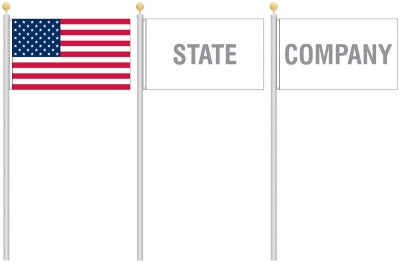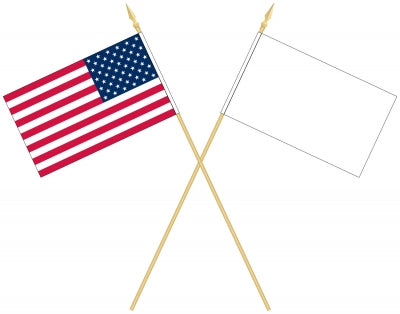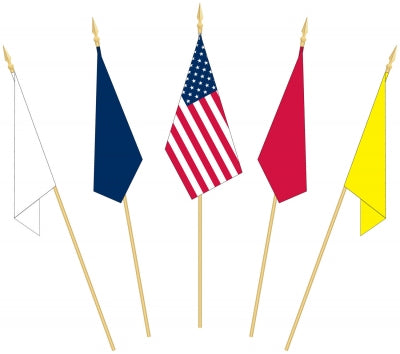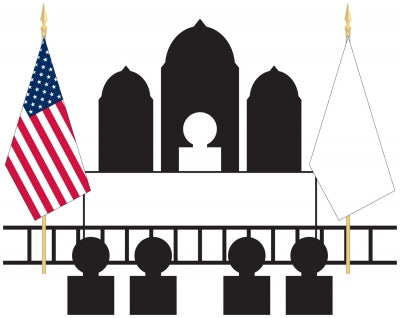When to Display the Flag
The flag should be displayed on all days when weather permits, especially on legal holidays or other special occasions. It is customary to display the flag from sunrise to sunset on buildings or on stationary flagstaffs in the open. However, on special occasions it may be displayed at night, preferably lighted. In several places the flag flies day and night; among these are the Capitol in Washington, D.C., and the Fort Henry National Monument in Baltimore, which was the inspiration for “The Star Spangled Banner" by Francis Scott Key.
The flag should be displayed…
• on or near the main administration building of every public institution
• in or near polling places on election days
• in or near schools when they are in session
A citizen may fly the flag on any day he wishes.
How to Fly the Flag
The flag should be raised and lowered by hand. Never, raise the flag while it is furled; unfurl, then hoist quickly to the peak of the flagstaff. It should be lowered slowly and ceremoniously. The flag should never be allowed to touch anything beneath it, such as the ground or the floor.
The flying of the flag at half-staff, is a sign of mourning. When flown at half-staff, the flag should be first hoisted to the peak, then immediately lowered to the half-staff position. It should be raised to the peak again for a moment before it is lowered for the day. “Half-staff" is the point midway between the top and bottom of the flagstaff. On Memorial Day in May, the flag should fly at half-staff from sunrise until noon, and at full-staff from noon until sunset.
At sea services by Navy chaplains, the church pennant may be flown above the flag.
No other flag may be flown above The United States flag except at the United Nations Headquarters. The UN flag may be placed above flags of all member nations. In the UN enclave, national flags of all members are flown with equal prominence.
When the flags of two or more nations are displayed together they should be flown from separate staffs of the same height, and the flags should be of approximately equal size. International usage forbids the display of the flag of one nation above that of another in time of peace.
How to Display the Flag
When carried in procession with another flag or flags, the Stars and Stripes should be at the right-front of the column, or when there is a line of other flags, in front of the center of that line. The flag should never be carried flat or horizontally, but always aloft and floating free.
When a number of flags are grouped and displayed from staffs, the flag of the United States should be in the center or at the highest point of the group. When displayed with another flag from crossed staffs, the flag of the United States should be on the right (the flag’s own right), and its staff should be in front of the staff of the other flag.
If the flag is displayed from a staff projected from a window sill, balcony or front of a building, the union of the flag should go to the peak of the staff (unless the flag is to be displayed at half-staff).
When the flag is displayed in any manner other than being flown from a staff, it should be displayed flat, whether indoors or out. If displayed either horizontally or vertically against a wall, the union should be uppermost and to the flag’s own right; that is to the observer’s left. When displayed in a window it should be suspended in the same way-that is, with the union to the left of the observer in the street.
When displayed over the middle of the street, the Stars and Stripes should be suspended vertical with the union to the north on an east-west street and to the east on a north-south street.
When the flag is suspended over a sidewalk from a rope extending from house to pole at the edge of the sidewalk, the flag should be hoisted out from the building toward the pole union first.
When used on a speaker’s platform the flag may be displayed flat, above and behind the speaker. If flown from a staff it should be on the speaker’s right; all other flags on the platform should be on his left.
When it is displayed on the pulpit or chancel in a church, the flag should be flown from a staff placed on the clergyman’s right as he faces the congregation. All other flags on the pulpit or chancel should be on his left.
However, when the flag is displayed on the floor of a church or auditorium, on a level with the audience, it is placed to the right of the audience.
When flags of states or cities, or pennants of societies, are flown on the same halyard with the flag of the United States, the latter should always be at the peak. When flown from adjacent staffs, the Stars and Stripes should be raised first and lowered last.
When used to cover a casket, the flag should be placed so that the union is at the head and over the left shoulder. The flag should not be lowered into the grave or allowed to touch the ground. The casket should be carried foot-first from the hearse to the grave.
Saluting the Flag
In saluting the flag those present in uniform should render the military salute. When not in uniform, men should remove the hat with the right hand and hold it at the left shoulder, the hand being over the heart. Women, and men without hats, should place the right hand over the heart. Aliens should stand at attention.
All persons present should face the flag, stand at attention and salute on the following occasions:
1. When the flag is passing in a parade or review. The salute to the flag in the moving column is rendered at the moment the flag passes.
2. During the ceremony of hoisting or lowering the flag.
3. When the National Anthem is played and the flag is displayed.
4. During the Pledge of Allegiance - I pledge allegiance to the flag of the United States of America and to the Republic for which it stands, one Nation under God, indivisible, with liberty and justice for all.
When the National Anthem is played and the flag is not displayed, all present should stand and face toward the music. Those in uniform should salute at the first note of the anthem, retaining this position until the last note. All others should stand at attention, men removing their hats. When the flag is displayed, all present should face the flag and salute.
How to Dispose of Worn Flags
Every precaution should be taken to prevent the flag from becoming soiled. When a flag is in such a condition, through wear or damage, that is no longer a fitting emblem for display, it should be destroyed privately in a dignified manner.
The flag should NEVER
1. Be tilted (dipped) even momentarily to any person or thing. Regimental colors, State flags, organization or institutional flags may be tilted as the mark of honor.
2. Be displayed with the union down except as a signal of distress.
3. Be carried flat or horizontally, but always aloft and floating free.
4. Be displayed on a float, motor car or boat except from a staff.
5. Be allowed to touch the ground or floor, or brush against objects.
6. Have objects placed on, over it, or be used as a covering for a ceiling.
7. Have any mark, insignia, letter, work, figure, picture or drawing of any nature placed upon or attached to it.
8. Be used as a receptacle for carrying anything, or be used to cover a statue or monument. If used in connection with unveiling ceremonies, it should not serve as a covering of the object being unveiled.
9. Be used for advertising purposes or have advertising signs fastened to its staff or halyard.
10. Be embroidered on such articles as handkerchiefs or cushions, or be printed or otherwise impressed on boxes.
11. Be used as a costume or athletic uniform or part of one.
12. Be used as drapery of any sort whatsoever, never festooned, drawn back or up in folds, but always allowed to fall free. Bunting of blue, white and red-always arranged with the blue above, white in the middle, and red below-should be used for such purposes of decoration as covering a speaker’s desk or draping the front of a platform.
Display American Flag off Staff
When the flag is displayed in any manner other than being flown from a staff, it should be displayed flat, whether indoors or out. If displayed either horizontally or vertically against a wall, the union should be uppermost and to the flag's own right; that is to the observer's left. When displayed in a window it should be suspended in the same way-that is, with the union to the left of the observer in the street.

Displaying U.S. Flag with State, City or Society Flags
When flags of states or cities, or pennants of societies, are flown on the same halyard with the flag of the United States, the latter should always be at the peak. When flown from adjacent staffs, the Stars and Stripes should be raised first and lowered last.

Displaying U.S. Flag with Foreign Flags
No other flag may be flown above the United States flag except at the United Nations Headquarters. The UN flag may be placed above flags of all member nations. No other flag can be placed to the United States flag's right.

Displaying U.S. Flag with Crossed Staffs
When displayed with another flag from crossed staffs, the flag of the United States should be on the right (the flag's own right), and its staff should be in front of the staff of the other flag.

Displaying U.S. Flag in Grouping
When a number of flags are grouped and displayed from staffs, the flag of the United States should be in the center or at the highest point of the group.

Displaying Nation Flags Together
When the flags of two or more nations are displayed together they should be flown from separate staffs of the same height, and the flags should be of approximately equal size. International usage forbids the display of the flag of one nation above that of another in time of peace.

Displaying U.S. Flag in a Church
When it is displayed on the pulpit or chancel in a church, the flag should be flown from a staff placed on the clergyman's right as he faces the congregation. All other flags on the pulpit or chancel should be on his left.

What should be the position of the flag when displayed from a staff in a church, public auditorium or other public meeting place, whether indoors or outdoors, on platform or on floor or ground level?
When used on a speaker’s platform, the flag, if displayed flat, should be displayed above and behind the speaker. When displayed from a staff in a church or public auditorium, the flag of the United States of America, should hold the position of superior prominence, in advance of the audience, and in the position of honor at the clergyman’s or speaker’s right as he faces the audience. Prior to the Flag Code changes in 1976, the display procedure was somewhat different. Now the staffed flag should always be placed to the right of the speaker without regard to a platform or floor level.

